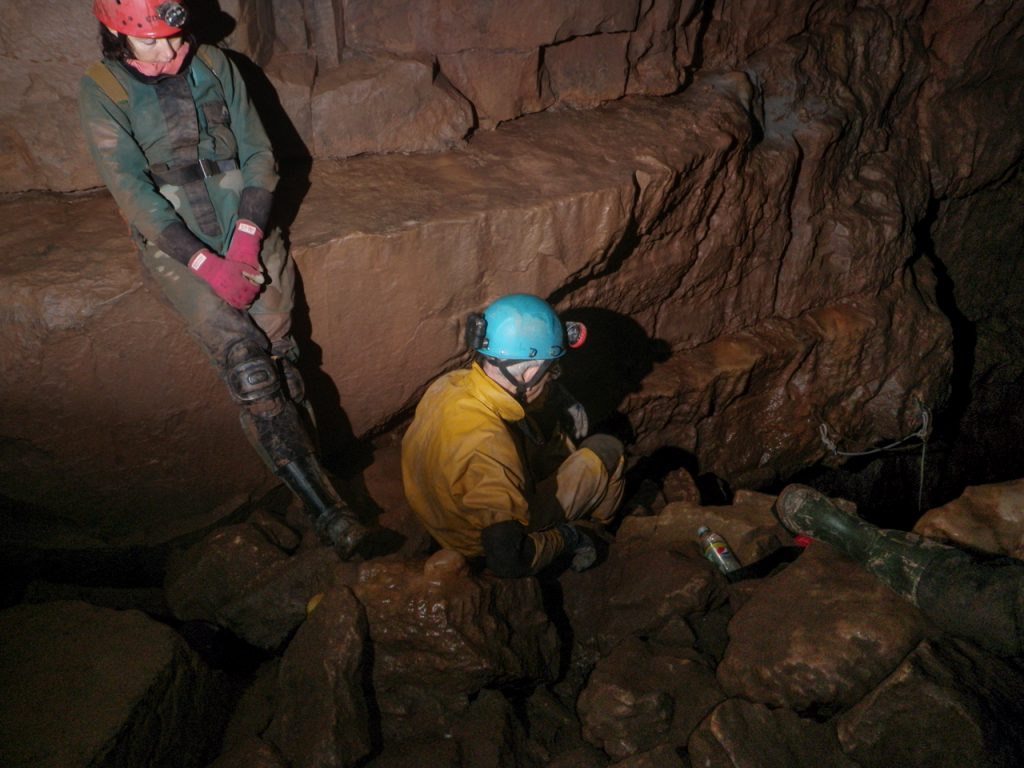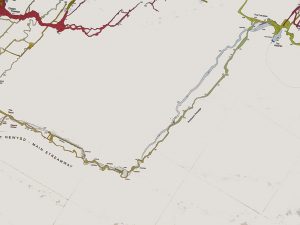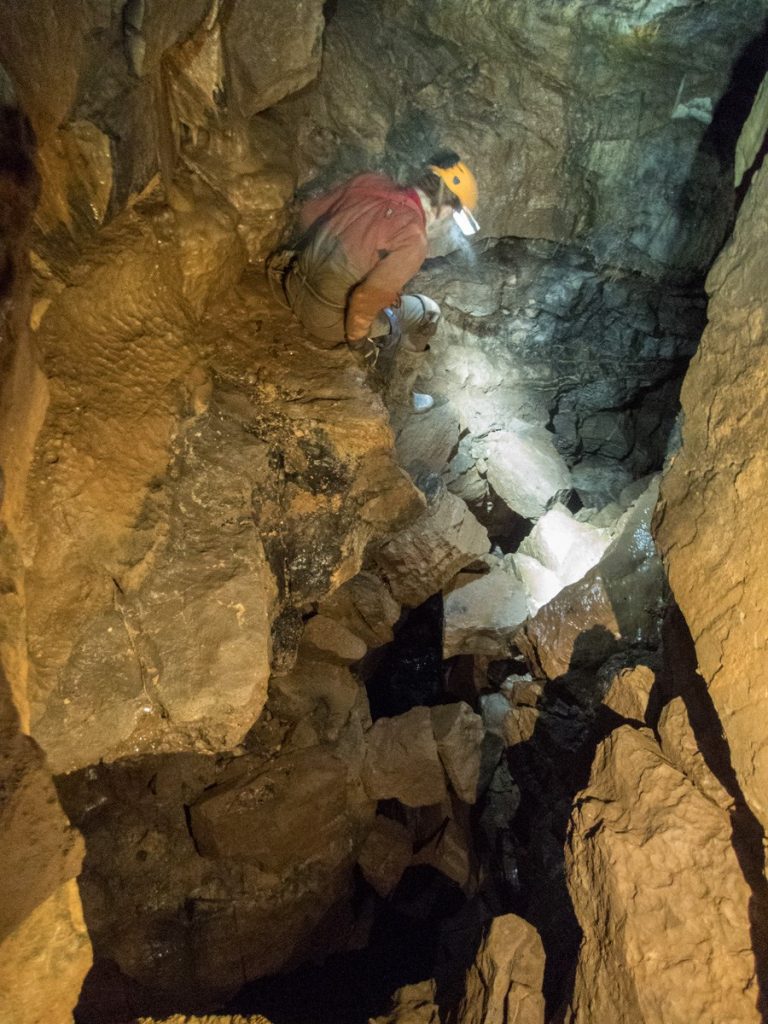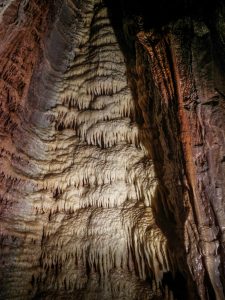
Even though writers are all notorious liars, the following is something resembling a true account of a caving trip I took on my New Year vacation. This is the kind of stuff that inspires my caving-related fiction.
Ogof Ffynnon Ddu: Top Entrance to the Crevasse
Shortly after noon Duncan, Tor and I crawl in through the top entrance hatch of OFD. Tor is tasked with navigation at first; I’ll back him up should he need it. We clamber over the boulders making up the first part of the cave, and in ten minutes we have reached the point, where a blocky climb called the Corkscrew heads down. Instead of down, we go up – up a slippery, muddy set of steps that’s almost unnoticeable if you go the way people usually go. The climb is unsecured and scary – a harbinger of what to expect today.
First up, then down, to the bottom of Arete Chamber, then into a tight, muddy meander that requires occasional sideways crawling. I’m the only member of our team to have been to this section of the cave before, so I take my place as the point man and navigator. The meander is not as arduous as I remember, and quickly we reach a sizable chamber with a block that’s called Timo’s Table. From here we head east.
Blocky, low climbs and spacious intersections follow. The notorious Poached Egg climb has a rope, rigged by Taina and her team two days earlier. About an hour after entering the cave we reach the Crevasse. It’s a deep shaft, likewise rigged earlier by the same people. From here on out we’re in unknown territory.
Pendulum Passage in Theory
Ogof Ffynnon Ddu, or OFD, is the second-longest cave in Wales, located in the Upper Swansea Valley. Administered by the South Wales Caving Club, OFD has sixty kilometres of known passage. I’ve been coming here to cave since 2009. In a dozen visits to the SWCC, and fifty trips to OFD, I think I’ve done about maybe 20% of the system.

When thinking about the trips I might do this time, I’d spotted Pendulum Passage on the survey. It’s a remote, north-south passage turning west at about 2/3 of the way in, an old stream tunnel that has long since lost all its water to the present main streamway, and only dusty boulders remain. I had no idea what it might contain, or how difficult a trip in it might be.
Both ends of Pendulum Passage are pitches. The north end is the Crevasse, a 22-metre shaft, and the south end is a two-parter called the Nave, likewise some 20 metres all together. Since the passage is below the level of its end points, both the Crevasse and the Nave need to be rigged with ropes in order to be able to get out the other way.
Velma, Miri and Taina have gone underground to rig the Nave pitches. In theory this is supposed to be an exchange trip: two teams heading into opposite directions meet somewhere in the middle, and derig the end they come up. In practice it’s likely only our team will attempt a through trip – the others have declared they are not going to attempt any heroic epics, and will probably go out the way they came in, just leaving the ropes for us. I’m not entirely certain about my ability to do heroic epics, either. I haven’t done any proper caving in more than a year due to a shoulder problem, and I managed to shake off a cold just before setting of to Wales for New Year. But Tor and Duncan are not as familiar with OFD as me, and the way to the Crevasse is a confusing maze. If this trip is to happen, I’m needed at least for the first leg. And once we’re through that, might as well go all the way.
We have no idea what to expect between the Crevasse and the Nave. We’ve reserved an eight-hour ticket. It’s possible the trip gets done in two. Duncan has photos of the survey in his camera, and we’re carrying a couple of extra ropes just in case.
Southward
One after another we abseil down Crevasse. It hasn’t been rigged quite all the way, and the first thing Pendulum Passage offers us is a genuinely South Welsh bolting on a rope section. Even though the pitch head has sensible belays, the lower parts sport cruddy old pieces of tat, rusty maillons and a sleeve that you just cannot properly screw a hanger into. The textbook thing to do with anchors like this is not to use them, and if there’s no choice, rather abort the trip than rely on them. We ignore the safety rules, since we figure the last bit of the pitch is only six metres and besides the rules are made for places other than Wales.
The dubious anchors hold, we reach the end of the rope, and the bottom, in a way. The passage around us is wide and blocky. We need to immediately start climbing up big, slippery boulders, then start down again, then up again, down again. On the survey Pendulum Passage is a series of short climbs, and it seems that for once, the reality matches the map. I figure this up-down rhythm must be how the place got its name.
It doesn’t take us long to reach the first descent we really don’t want to do without a rope. A full SRT pitch doesn’t look like something that is required, or indeed even possible to rig here, so we just loop the rope around a boulder and use it as a handline. I go down first, trying to get a feel of the descent, and to get by without the rope. It almost works, but there’s a really hairy section close to the bottom where I have to grab the rope and use it as a handhold. It would be easier getting up, I hope. Even so, after we’re all down we figure that if the passage continues like this, we’re not keen to pull down our only exit rope just yet. So my 8-mil 20-metre rope can stay where it is. It might just as well stay here forever, to help the next party to come this way.
The climbs and descents don’t get any easier, quite the opposite. In any other part of the world this section of the cave would be full of little pitches, but not in South Wales, where life is short and miserable. If somebody has free-climbed it, the logic goes, there’s no need to complicate things with ropes. We rig more handlines for the worst descents, and since the ropes we use belong to the club, we need to pull them down after us. Now we’re starting to feel really committed to the trip.
Even if the passage is just a north-south pipe on the survey, in reality route-finding isn’t as trivial as you might think. The ever-amusing third dimension provides us with lots of opportunities to scratch our heads, as piles of boulders provide little indication whether to climb over or squeeze under them. Tor has previously wished for a trip that didn’t require flat-out crawling, and it’s probably the only way of moving about that we don’t need to use. Squeezing into a boulder choke is totally different from crawling.
We’re all on equally unfamiliar ground here. Our division of labour is fairly equal as well – although withoug my glasses I don’t really participate in trying to make sense of the survey photos. Instead I seem to be doing much of the point climbing and descending, which suits me perfectly. On our ticket I’m listed as the trip leader, but in reality this means only that I’m the one who gets blamed if things go wrong. There are plenty of opportunities for that. At one point we come across a free descent of 10 metres, too long for even our ropes to be of any help. When Tor, who’s at the point, pokes a largish boulder and starts it rolling down, the rumbling seems to go on forever.
There’s a term – “exposed” – describing places with a deep drop underneath and no real way to secure yourself. Exposed is fast becoming a theme for this trip. Other words we come back to are “committing” and possibly “dangerous”. However, it doesn’t cross our minds to use the words “boring” or “tedious”, because Pendulum Passage is definitely not dull. Challenges keep coming – of body, of brains, of confidence.
After maybe two hours of pushing on we start to hear the water. Soon we come to a hole in the floor, dropping about 10 metres into the stream. This is a possible escape route: I’ve been in the streamway below us before, and know how to get out if needed. But in reality none of us wants to leave our present path. We’re having way too much fun.
For about half a minute the climbs let up, and we walk along a tunnel with a sandy floor. Then the boulders come back, and calcite formations start adorning the walls. We’re approaching the point where the passage turns west, just a bit over the half-way mark of this trip.
Going West
The wide passage meanders, and the walls are covered by long straws and complicated helictites. We slow down. You have to move like a ghost among the fragile cave formations in order not to break them by accident. Only in a place like this, visited only by a couple of parties a year, fantastic things such as these can remain undamaged. We try not to even breathe at them.
Water dripping from the ceiling provides an opportunity to refill my water bottle. So far it’s been a fairly dry trip, but we should be getting closer to the stream. If everything goes as planned, we’re not exactly going to enter it.
It’s four o’clock. Half of the time on our ticket has passed, but we’ve been moving fast. Eight hours seems like a good estimate for the trip, and it even has some slack. After a couple more climbs, descents and peculiar route-finding problems we realise we’re going to need it.
We pop out on a mid-sized balcony with a floor of boulders. Eight metres below us is roaring water. According to the survey there are two ways on: one looks to be a narrow crawl, another a traverse over the stream. Previously I’ve voiced my support for the traverse, as crawling doesn’t really sound inspiring. Now, looking at the wide stream ahead, I wonder if this is at all a sensible idea.
Using a handline I slide five feet down, into an alocve beneath the balcony. The ceiling is a big boulder, the floor consists of smaller rocks that seem to stay in place by levitation. A rope goes around the ceiling boulder. It’s no ordinary caving rope, either – it’s a thick, at least 15-mil cable, like something you might expect to find on a ship. It goes all the way down to the stream, and a stronger caver could possibly use it to climb up or down. But it cannot be the way the Pendulum Passage route is supposed to go, no way. I try to understand the way on, and then I see it. The Welsh cavers are maniacs.
I grab the rope, make sure it’s reasonably safe, and like some Tarzan of the Underworld, swing across from the floating boulders onto a ledge on the opposite side of the streamway chasm. It’s not exactly a long way to swing (just a little pendulum, it occurs to me) and the move isn’t particularly difficult, but the streamway is still over six metres below me. There’s no security. There’s no margin for error. Fortunately, I don’t slip.
From the ledge I traverse onwards. The chasm below me is wide, and for anyone under six feet tall the going would be rather extreme. It’s not a picnic for me either. Part of the way downstream I spot another bunch of wedged boulders five feet below, probably the way the traverse continues. There’s no sane way to get to them however. You need to drop down. The stream is still five metres above them. If you drop and lose your footing, you’re in trouble.
The traverse is starting to feel unreasonably demanding. I backtrack to the alcove. The traverse is even more hairy the other way, and there’s a part where I need to spider-walk with hands and feet on different walls, crouched with the wide chasm below me. I see my head torch reflected in the water below. I decide that my acrophobia has no right to make as much as a peep today.
I report to Tor and Duncan that the traverse seems fiendishly hard. In the meantime they’ve studied the survey, which is really confusing at this point, and have deciphered that both the traverse and the crawl start from somewhere above the stream. We have no choice at this point. We have to get to the boulders above the stream.
I use a rope to lower my water bottle into the stream and refill it. After properly quenching my thirst I return to the traverse. Swing on a rope, wide spider-walk, a ledge on the left-hand side of the stream. The boulders are below me. There is nothing to hold on to. I try to locate footholds, but there are none. So I just drop down.

I fall on my feet on top of the boulders. They don’t come loose, I don’t stumble, nothing falls into the stream. My heart is hammering. On the balcony Duncan is cheering. Tor and him are not going to repeat the stunt – and I cannot really recommend they do, either. Instead, they’re going to rig a rope to abseil from, and use that to swing onto the same level I’m on.
I sit down on the wedged boulders, and wait. It takes a while to rig the pitch: there are no good anchors, and the ropes we have need to be tied together for them to reach the boulders. Eventually the pitch is ready. First Tor, then Duncan abseil down, over the edge of the balcony, on the same level with me. By pushing against the wall they can swing onto the boulders.
When the rope descent has been proven to work, I traverse onwards. The streamway meanders a couple of times – and then the traverse is blocked by a truly massive calcite growth. A stupendous amount of off-white flowstone has formed an underground sculpture high above the stream. There’s no way through it. There’s no way over it. Underneath the passage widens. There’s no way down.
I relay a situation report that’s rather desperate. But according to the survey this is the way on, and the passage turns exactly like the one on the map. I’ve missed something here.
I return to the calcite blockage, and peer under it. There are slippery calcite slopes beneath, and they seem to continue. I bend down to look, and see darkness ahead. There’s not much headroom here, but the traverse goes on – underneath the flowstone mass! I report that we’re back in business.
Slipping under the flowstone blockage is the hardest part of the traverse. It’s wide and not very high, and the ledges used are slippery. After some six metres the way on becomes a narrow ravine almost blocked by flowstone. The rift in the middle is too narrow to fall through; going is a bit awkward, but not dangerous. Mostly you just have to be careful not to break any of the beautiful and fragile formations that surround the traverse.
After maybe fifty metres the traverse ends in a blocky chamber. A proper rope goes down into the stream here, but we still don’t want to use it. Instead we locate a narrow climb onwards, and at the end we come to a shiny, white caving rope leading up. Miri, Taina and Velma have been here, and have rigged the exit rope for us.
The Nave to Top Entrance

Seeing the rope causes the soundtrack in my head to start playing Beethoven’s Ode to Joy. We’ve taken over an hour to putter about in the traverse, and it’s almost seven o’clock. But the rope indicates that we’re just about at the end of our trip.
The Nave pitch consists of two separate sections, and the rigging party has had to use three ropes, because the pitch heights indicated by the survey have been somewhat inexact. But the rigging is good and safe, and even as tired as we are, we have no problems getting up. We derig the ropes behind us. After two beautiful, high chambers we’re back in the middle levels of OFD.
We pass the calcite formations called the Judge and the Trident, and reach Salubrious Stream, the gentle north-south waterway that serves as something of a main route in this part of the cave. I feel like I’ve come home. This is the point where my endurance just about runs out. Walking upstream is really slow, and in one climb my upper body strength simply fails, and I fall half a metre into shallow water. Luckily I don’t hurt myself.
Up the stream, up the Corkscrew, through the Brickyard on feet that no longer feel at all steady. Out of the hatch into the dark and cool evening. Far ahead, in the valley, the village lights are shining. It’s quarter to eight.
The walk down the hill is trimphant. It’s been a tough, challenging, varied, incredibly great trip. We reach the caving cottage at eight o’clock sharp. There’s hot tea and dinner waiting for us. It’s time to swap stories with the rigging party, and hear how they got the ropes down the Nave.
This has been a true story of underground mischief. For caving fiction, check out my suspense novel Not the Dark That Kills You, out now!
[…] ilmeisen eeppinen retki, täynnä haastavia kiipeilyjä sekä hurjia poikkareita virran yllä (Daren retkikuvaus englanniksi). Olimme epäilleet, että luovia köysiratkaisujamme moitittaisiin, mutta itse asiassa saimme vain […]